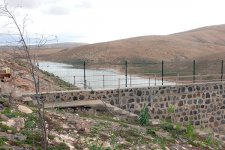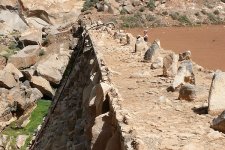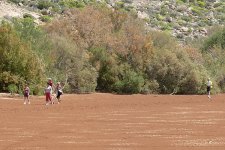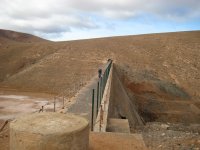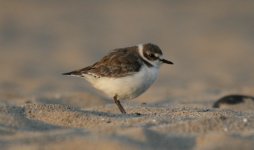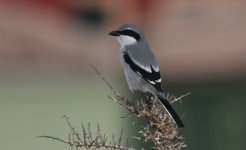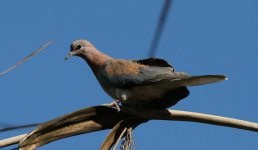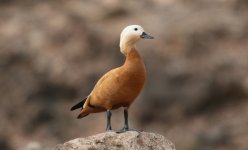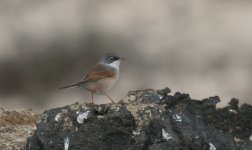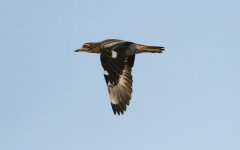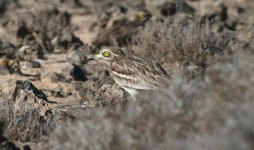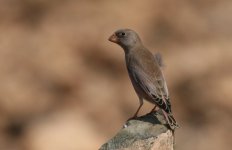While the good birding spots on the island are well know I struggled to find much info about the area around Corralejo. We went for a family holiday to Corralejo for 11 days.
I walked the beach on morning from our hotel to end South end of town and continued towards the Oliva Beach Hotel for about 1.5 km, then crossed the road into the dunes with scrubs making my way back into town.
Kentish Plover, Whimbrel, Bar-tailed Godwit, Ringed Plover, Grey Plover, Sanderling, Common Sandpiper and Turnstone were all seen on the rocks at the beach. The first group of 12 Trumpeter Finches were by the large hotel at the southend of town and the derelict apartments. Nothing significant on the seaside beach walking towards the Oliva Beach hotel apart from a Spectacled Warbler. On the landside of the road there where good numbers of Berthelot's Pipits, Spectacled Warblers, one Great Grey Shrike, a small flock of Linnets and a couple of flyover Ravens.
I did bird the dunes west of the town briefly twice later during the holiday. Trumpeter Finches (group of 15) were found easily just by the pavement and there where good numbers of Linnets (up to 250), Hoopoe (10 seen one afternoon) and a group of up to 8 Stone Curlew which where only about 150m from the road/the nearest buildings.
Between the roundabout near the shopping centre (with the tall clock tower) and the dunes to the West of town there is a small area with some palm trees in it. There were at least 4 Laughing Doves in there (only seen in the afternoon) as well as a group of Trumpeter Finches.
Other birds of note where a few Cory's Shearwater offshore and a Sardinian Warbler in the scrub by the Oliva Hotel bus stop.
We hired a car for one day with the intention of going to Los Molinos, Las Penitas and La Oliva.
Los Molinos
The reservoir is completely dry and i can't see this changing with the rain levels they've got on the island.
By the goat farm there where 5 Ruddy Shelduck and (as I found out later) Black-bellied Sandgrouse amongst the goats. In the area by the dam we had Black-bellied Sandgrouse (heard only), Barbary Partridge and Cream-coloured Courser. There is a small track going down into the Barranco de la Molinas. I walked down and saw one pair of Fuerteventura Chat, about 150 Trumpeter Finches, Hoopoe, Raven, Little Ringed Plover and Common Sandpiper.
Las Penitas
We went there mainly to see African Blue Tit and to check the reservoir for wildfowl. I didn't see any of the latter as the reservoir is completely dry too. Walking from the bridge for about 200m through a group a palm trees/shrubs African Blue Tit was found easily. This form has a wing-bar and is the same as found in NE Africa. Also present where Raven, a number of Sardinian Warblers, Blackcap, Robin, Goldfinch and Hoopoe. I didn't walk the track any further to look for Fuerteventura Chat as I had seen them earlier.
La Oliva
A couple of Houbara Bustards were seen exactly as in Dave Gosney's book / Tony Clarke's book (in the cultivations Roas de los Negrines). I've miss-timed arrival (looking in another area first) and missed them coming down the hill side. Thanks to the birders pointing them out to me in the cultivations. They also had several Cream-coloured Coursers while waiting for the Houbaras. The best place to park is either by the palm trees leading to the most northerly farm and scan from the car or a little bit higher up on the hill side. The birds appeared not long after 3pm. Lesser Short-toed Larks where also in this area.
I've only recorded 46 species but given the limited birding time and the fact that both reservoirs were dry I think that's fairly good. Shame I didn't see BB Sandgrouse (not to mention Barbary Falcon) but I didn't miss much else. All the common species can be recorded around Corralejo, for the desert birds you need to hire a car.
Very enjoyable holiday. Nice, pleasant and warm. Shame to have to come back to such cold temperatures here in the UK
I walked the beach on morning from our hotel to end South end of town and continued towards the Oliva Beach Hotel for about 1.5 km, then crossed the road into the dunes with scrubs making my way back into town.
Kentish Plover, Whimbrel, Bar-tailed Godwit, Ringed Plover, Grey Plover, Sanderling, Common Sandpiper and Turnstone were all seen on the rocks at the beach. The first group of 12 Trumpeter Finches were by the large hotel at the southend of town and the derelict apartments. Nothing significant on the seaside beach walking towards the Oliva Beach hotel apart from a Spectacled Warbler. On the landside of the road there where good numbers of Berthelot's Pipits, Spectacled Warblers, one Great Grey Shrike, a small flock of Linnets and a couple of flyover Ravens.
I did bird the dunes west of the town briefly twice later during the holiday. Trumpeter Finches (group of 15) were found easily just by the pavement and there where good numbers of Linnets (up to 250), Hoopoe (10 seen one afternoon) and a group of up to 8 Stone Curlew which where only about 150m from the road/the nearest buildings.
Between the roundabout near the shopping centre (with the tall clock tower) and the dunes to the West of town there is a small area with some palm trees in it. There were at least 4 Laughing Doves in there (only seen in the afternoon) as well as a group of Trumpeter Finches.
Other birds of note where a few Cory's Shearwater offshore and a Sardinian Warbler in the scrub by the Oliva Hotel bus stop.
We hired a car for one day with the intention of going to Los Molinos, Las Penitas and La Oliva.
Los Molinos
The reservoir is completely dry and i can't see this changing with the rain levels they've got on the island.
By the goat farm there where 5 Ruddy Shelduck and (as I found out later) Black-bellied Sandgrouse amongst the goats. In the area by the dam we had Black-bellied Sandgrouse (heard only), Barbary Partridge and Cream-coloured Courser. There is a small track going down into the Barranco de la Molinas. I walked down and saw one pair of Fuerteventura Chat, about 150 Trumpeter Finches, Hoopoe, Raven, Little Ringed Plover and Common Sandpiper.
Las Penitas
We went there mainly to see African Blue Tit and to check the reservoir for wildfowl. I didn't see any of the latter as the reservoir is completely dry too. Walking from the bridge for about 200m through a group a palm trees/shrubs African Blue Tit was found easily. This form has a wing-bar and is the same as found in NE Africa. Also present where Raven, a number of Sardinian Warblers, Blackcap, Robin, Goldfinch and Hoopoe. I didn't walk the track any further to look for Fuerteventura Chat as I had seen them earlier.
La Oliva
A couple of Houbara Bustards were seen exactly as in Dave Gosney's book / Tony Clarke's book (in the cultivations Roas de los Negrines). I've miss-timed arrival (looking in another area first) and missed them coming down the hill side. Thanks to the birders pointing them out to me in the cultivations. They also had several Cream-coloured Coursers while waiting for the Houbaras. The best place to park is either by the palm trees leading to the most northerly farm and scan from the car or a little bit higher up on the hill side. The birds appeared not long after 3pm. Lesser Short-toed Larks where also in this area.
I've only recorded 46 species but given the limited birding time and the fact that both reservoirs were dry I think that's fairly good. Shame I didn't see BB Sandgrouse (not to mention Barbary Falcon) but I didn't miss much else. All the common species can be recorded around Corralejo, for the desert birds you need to hire a car.
Very enjoyable holiday. Nice, pleasant and warm. Shame to have to come back to such cold temperatures here in the UK
Last edited:




